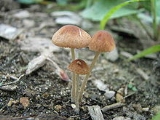
Conocybe smithii
Encyclopedia
Conocybe smithii is a rare member of the genus Conocybe
which contains the hallucinogenic alkaloid psilocybin
. It was formerly known as Galera cyanopes.
and often grows in bogs, ditches and swampy areas, commonly in sphagnum
moss. Also found along river banks and in lawns.
It is known to occur in Canada
, Oregon
, Wisconsin
, Washington, and Michigan
, but is probably more widely distributed.
On the west coast of America, Conocybe smithii is an early summer mushroom, almost never appearing after the first week of June.
, psilocybin
, and baeocystin
. Most mycologists recommend against eating this mushroom because it is difficult to distinguish from poisonous species.
Conocybe
The genus Conocybe is a genus of mushrooms consisting of Conocybe tenera and at least 243 other species, with at least 50 species in North America....
which contains the hallucinogenic alkaloid psilocybin
Psilocybin
Psilocybin is a naturally occurring psychedelic prodrug, with mind-altering effects similar to those of LSD and mescaline, after it is converted to psilocin. The effects can include altered thinking processes, perceptual distortions, an altered sense of time, and spiritual experiences, as well as...
. It was formerly known as Galera cyanopes.
Description
- Cap: 0.3 - 1(1.3) cm across Conic to convex but expands to nearly plane in age, with a distinct umbo, smooth, ochraceous tawny to cinnamon-brown, darker at edges, glistening when wet, hygrophanous, even to striate when moist. Lightens when it dries, turning a tan color.
- Gills: adnate to adnexed, crowded to subdistant, narrow to moderately broad, pale grayish yellow to brown with whitish edges, darkening to rusty cinnamon brown in age.
- Spores: Cinnamon brown, (6.5)7.0 - 9.0 x 4.0 - 4.5(5) micrometers smooth and ellipsoid with thick walls and a small but distinct germ-pore.
- StipeStipe (mycology)thumb|150px|right|Diagram of a [[basidiomycete]] stipe with an [[annulus |annulus]] and [[volva |volva]]In mycology a stipe refers to the stem or stalk-like feature supporting the cap of a mushroom. Like all tissues of the mushroom other than the hymenium, the stipe is composed of sterile hyphal...
: (1)2 to 5(7.5) cm long, .75 - 1(1.5) mm thick, mostly equal but often slightly swollen at the base. Fragile, whitish with fine fibrils but becoming smooth, lacks an annulusAnnulus (mycology)An annulus is the ring like structure sometimes found on the stipe of some species of mushrooms. The annulus represents the remaining part of the partial veil, after it has ruptured to expose the gills or other spore-producing surface. An annulus may be thick and membranous, or it may be cobweb-like...
, slightly twisting striatulations, often slightly grayish at the base when young, becoming an azure shade of blue in age, quickly bruising blue when handled. - Taste:
- Odor:
- Microscopic features: Subcapitate cheilocystidia.
Distribution and habitat
Conocybe smithii is found in North AmericaNorth America
North America is a continent wholly within the Northern Hemisphere and almost wholly within the Western Hemisphere. It is also considered a northern subcontinent of the Americas...
and often grows in bogs, ditches and swampy areas, commonly in sphagnum
Sphagnum
Sphagnum is a genus of between 151 and 350 species of mosses commonly called peat moss, due to its prevalence in peat bogs and mires. A distinction is made between sphagnum moss, the live moss growing on top of a peat bog on one hand, and sphagnum peat moss or sphagnum peat on the other, the...
moss. Also found along river banks and in lawns.
It is known to occur in Canada
Canada
Canada is a North American country consisting of ten provinces and three territories. Located in the northern part of the continent, it extends from the Atlantic Ocean in the east to the Pacific Ocean in the west, and northward into the Arctic Ocean...
, Oregon
Oregon
Oregon is a state in the Pacific Northwest region of the United States. It is located on the Pacific coast, with Washington to the north, California to the south, Nevada on the southeast and Idaho to the east. The Columbia and Snake rivers delineate much of Oregon's northern and eastern...
, Wisconsin
Wisconsin
Wisconsin is a U.S. state located in the north-central United States and is part of the Midwest. It is bordered by Minnesota to the west, Iowa to the southwest, Illinois to the south, Lake Michigan to the east, Michigan to the northeast, and Lake Superior to the north. Wisconsin's capital is...
, Washington, and Michigan
Michigan
Michigan is a U.S. state located in the Great Lakes Region of the United States of America. The name Michigan is the French form of the Ojibwa word mishigamaa, meaning "large water" or "large lake"....
, but is probably more widely distributed.
On the west coast of America, Conocybe smithii is an early summer mushroom, almost never appearing after the first week of June.
Edibility
Mildly hallucinogenic, containing psilocinPsilocin
Psilocin , an aromatic compound, sometimes also spelled psilocine, psilocyn, or psilotsin, is a psychedelic mushroom alkaloid. It is found in most psychedelic mushrooms together with its phosphorylated counterpart psilocybin...
, psilocybin
Psilocybin
Psilocybin is a naturally occurring psychedelic prodrug, with mind-altering effects similar to those of LSD and mescaline, after it is converted to psilocin. The effects can include altered thinking processes, perceptual distortions, an altered sense of time, and spiritual experiences, as well as...
, and baeocystin
Baeocystin
Baeocystin is a mushroom alkaloid and analog of the psychedelic hallucinogenic drug psilocybin, a tryptamine derivative. It is found as a minor compound in most psychoactive mushrooms together with psilocybin, norbaeocystin, and psilocin...
. Most mycologists recommend against eating this mushroom because it is difficult to distinguish from poisonous species.

